Decision-making ability is regarded by executives as one of the most highly desired business skills! However, making decisions can be a daunting task, particularly when the stakes are high. As with the training of top-tier athletes, decision-makers can employ techniques, plans, and instruments to improve and achieve more. One such tool is the weighted pros and cons list, which was popularized by none other than Benjamin Franklin. This article will explore how a systematic approach to decision-making, utilizing Franklin's simple pros and cons tool, can lead to better outcomes. Furthermore, this write-up will examine the steps involved in this approach, highlight the benefits of this method, and provide an example of how it can be applied in an individual decision. By the end of this article, readers will have a greater understanding of how to make great decisions using a systematic approach, and the confidence to apply this knowledge in their own decision-making processes.
Note: All the images in the article were generated by Artificial Intelligence using **Stable Diffusion 2.x1. The pictures depicting "salespeople & teams" were generated by artificial intelligence (AI) and any likeness to anyone is a coincidence.
Background
Benjamin Franklin is one of the most well-known figures in American history, with his life and achievements having a significant impact on both the United States and the world. Born in Boston in 1706, Franklin was a man of many talents, excelling in areas such as printing, writing, science, and diplomacy. He is best known for his role in American politics and his contributions to the development of American society, such as his invention of the lightning rod and the bifocal lens.
However, Franklin's contributions extend beyond his inventions and political leadership. He was also a keen observer of human behavior, and his writings on decision making and problem-solving have had a lasting impact on the field of decision theory. Franklin developed a method for making decisions known as the pros and cons list, in which he would weigh the potential advantages and disadvantages of a particular choice. This method has become a staple in decision-making processes, and its effectiveness has been proven time and again with many research studies.
Ben Franklin's Pros & Cons Decision Making Method
Ben Franklin was a close friend of Joseph Priestley in the 1700s, who was himself a chemist, political theorist, educator amongst other things. As trusted friends, Ben Franklin and Joseph Priestley exchanged ideas throughout the years on many ideas. In the summer of 1772, via a letter Joseph Priestley sought advice from Ben Franklin about a high-stakes decision he had to make. Priestley had a decision to make between relinquishing his position as the minister of the fame Unitarian church Mill Hill Chapel in Leeds or accepting a very desirable position as the general assistant to the Earl of Shelburne. Rather than providing an opinion on which option to select, Ben Franklin responded to Priestley by teaching him how to make a decision using a systematic process!
Below is the actual letter Ben Franklin wrote in 1772 detailing the decision process to his friend Joseph Priestley:
When these difficult Cases occur, they are difficult chiefly because while we have them under Consideration all the Reasons pro and con are not present to the Mind at the same time; but sometimes one Set present themselves, and at other times another, the first being out of Sight. Hence the various Purposes or Inclinations that alternately prevail, and the Uncertainty that perplexes us.
To get over this, my Way is, to divide half a Sheet of Paper by a Line into two Columns, writing over the one Pro, and over the other Con. Then during three or four Days Consideration I put down under the different Heads short Hints of the different Motives that at different Times occur to me for or against the Measure. When I have thus got them all together in one View, I endeavour to estimate their respective Weights; and where I find two, one on each side, that seem equal, I strike them both out: If I find a Reason pro equal to some two Reasons con, I strike out the three. If I judge some two Reasons con equal to some three Reasons pro, I strike out the five; and thus proceeding I find at length where the Ballance lies; and if after a Day or two of farther Consideration nothing new that is of Importance occurs on either side, I come to a Determination accordingly.
And tho’ the Weight of Reasons cannot be taken with the Precision of Algebraic Quantities, yet when each is thus considered separately and comparatively, and the whole lies before me, I think I can judge better, and am less likely to take a rash Step; and in fact I have found great Advantage from this kind of Equation, in what may be called Moral or Prudential Algebra.
In bullet summary, these are the steps Ben Franklin recommends when making a decision, which he called his "Decision Making Method of Moral Algebra":
- Frame a decision that has two options (Yes or a No)
- Divide an area into two competing halves: a "Pro" side and "Con" side
- Label the top of one side "Pro" (for) and the other "Con" (against)
- Under each respective side, over a period of time (Ben Franklin recommended days, this could be minutes) write down various reasons/arguments that support (Pro) or are against (Con) the decision
- After spending some time thinking exhaustively and writing down the reasons, weight the different Pro and Con reasons/arguments
- Determine the relative importance of each reason or argument. This is done by taking reasons/arguments that are of similar value (weight) and crossing them off of the other competing half. Multiple reasons can be combined from one side to form a "subjective" value (weight) to balance out the other half. (For example, two medium "Pro" reasons might add up to an equal value of a single important "Con" reason)
- The side with the most remaining reasons is the option one should select for the decision in question
Example - Deciding on a Luxury Family Vacation
Let's assume a family is planning a luxury family vacation next year to the Maldives. How would the family approach this important decision using this decision-making framework? Taking the first 4 steps from the section above (frame the decision, provide for/con reasons in two halves), the family may write down the supporting reasons in the table below:
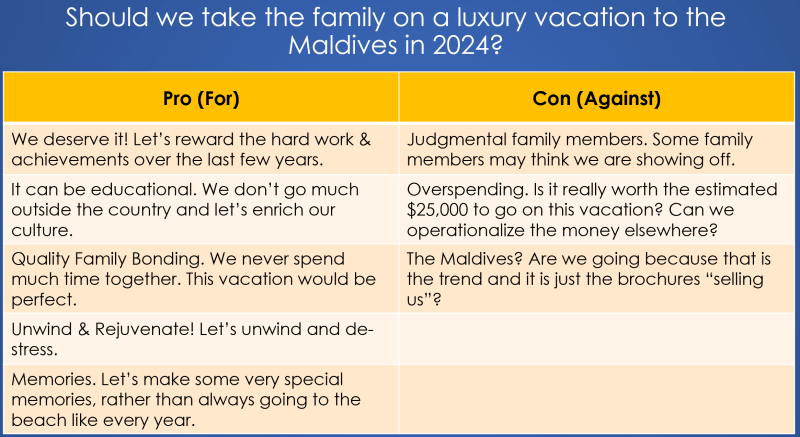
After making the initial list, the next steps are to spend some time thinking about the decision. For a luxury vacation, the family could consider spending a few days before making the final conclusion. During that thought-process, the family should rank the reasons and cross off the ones that are equal weights. In the table below, the reasons are now re-ranked and those of equal weights are crossed off. For example, Memories and Overspending are both weighted as #1 and equal each other out. However, there are two values in the Pro (For) column weighted as #3 that equal to one #3 Con (Against); those would cancel each other out as well. After crossing off the equal weights, the side with the most remaining reasons is the one that should be selected. Therefore, based on this decision-making process, the family is going on the luxury vacation!!!
Why This Simple 250 Year Old Decision Making Method Matters
Can you really make decisions using a simple process like this? In enterprise organizations, sophisticated decision support systems or management systems are powerful tools that use big data, artificial intelligence, statistical probabilities, or confidence interval ranges to make complex decisions. These complex systems are highly effective and can provide valuable insights that can be used to guide business strategies and improve overall decision-making. However, despite the effectiveness of these advanced decision systems, Ben Franklin's decision-making method is still relevant and necessary! For example, when Google bought YouTube, the Google executives had only one hour to accept the final term sheets!! In this high-stakes decision with a serious time crunch, there was simply no time to create a sophisticated decision model with AI/statistics! This is where simple systematic decision making processes demonstrate their true value.
One of the reasons why Ben Franklin's decision-making method is still important is that many people, both in their personal lives and in business, do not use a systematic or organized reasoning process when making important decisions. Instead, most individuals rely on their past experiences or subjective gut feelings when making decisions. This approach can be heavily biased and can lead to inconsistent decision-making. Humans have selective recall, are influenced by recent events, and are likely to make different decisions based on their current mood or personal preferences. These biases and personal preferences can impact the quality and objectivity of decisions made, and as a result, it is essential to have a structured approach to decision-making. The table below highlights the value simple decision making models can provide over simple intuition (experience), while illuminating that there are more advanced options available.
Ben Franklin's decision-making method provides a simple yet effective technique to overcome biases and personal preferences. This method encourages decision-makers to consider all factors involved in the decision-making process, including the potential benefits and drawbacks of each option. By examining both positive and negative factors, decision-makers can gain a clearer understanding of the implications of their choices, leading to more informed and balanced decisions.2
For those who are making crucial high-stakes decisions without any organized process, using Ben Franklin's decision-making method is a recommended starting point. This technique allows for a balanced review of the decision-making process, ensuring that all factors are considered before arriving at a final decision. By utilizing this method, decision-makers can minimize their biases and personal preferences, resulting in decisions made based on objective analysis and thoughtful consideration.
Footnotes
-
Stable Diffusion on Hugging Face: https://huggingface.co/spaces/stabilityai/stable-diffusion ↩
-
Business Analytics - Decision Making Process: https://www.techtarget.com/searchbusinessanalytics/definition/decision-making-process ↩


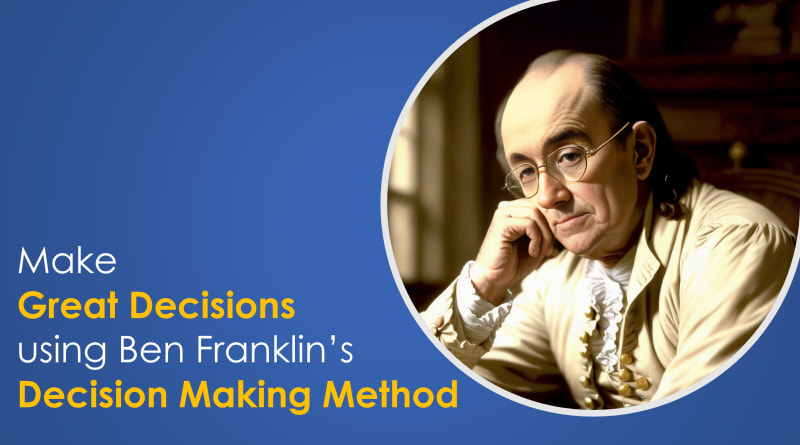

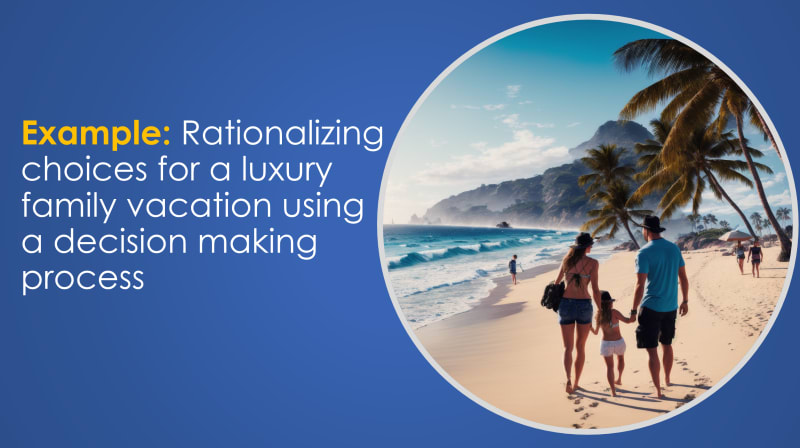
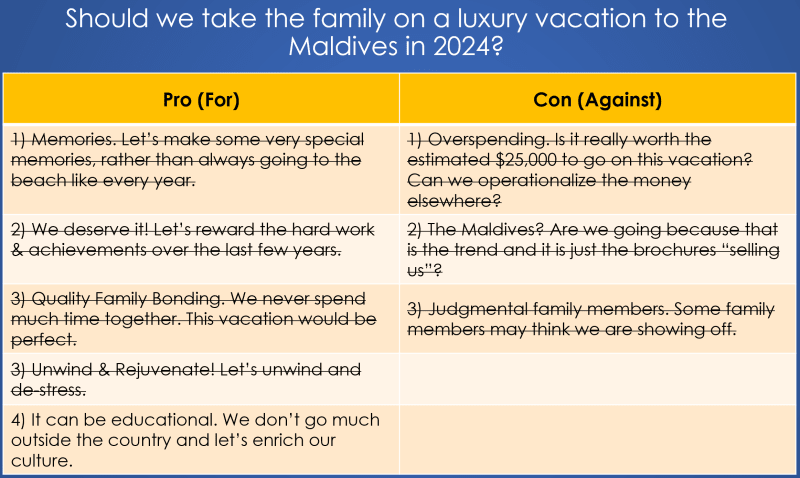

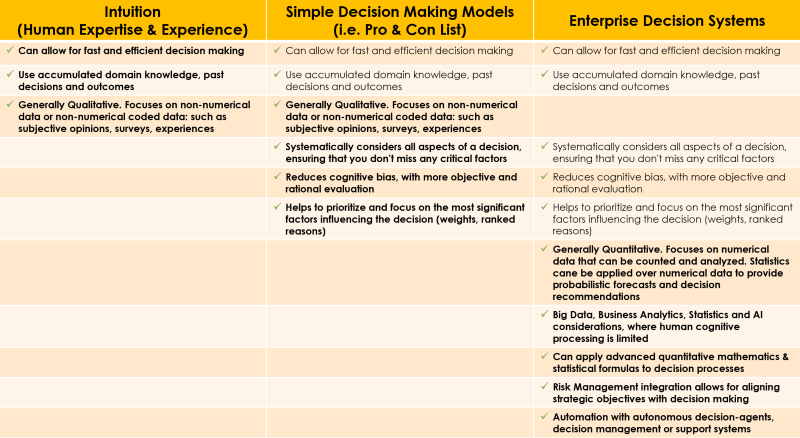

Top comments (0)